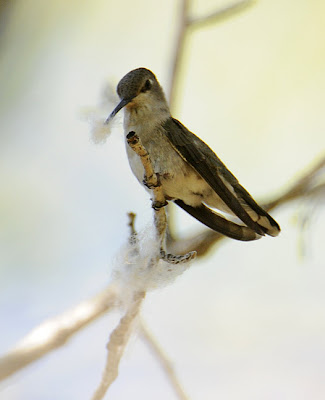Anyway, there is still always something interesting going on if you go out and look. On Sunday, Ted Floyd and I found a Black-chinned Hummingbird nest near Hygiene (yeah, a very clean town), a little hamlet in Boulder County. Seems like this might be the first nesting record in the county, but not completely unexpected since this species is expanding their range northward and have been found nesting in the next county north of here (Larimer.) We saw the bird carrying cottonwood down, and it hunkered in the nest a time or two, but didn't want to stay long for the time we waited. I wonder if it is still building the nest- no little bills peeking out over the rim were evident. Seems late, but the Birds of North America online (a must-have subscripiton for anyone even remotely interested in wild birds) indicates the potential for late nesting, particularly with potential second broods:
Texas: Egg dates 4 Apr-21 Jul, with young in the nest as early as 18 Apr and as late as 12 Aug (Oberholser and Kincaid 1974). At Big Bend National Park, arrival by the second week of Mar, with nesting beginning immediately; young ready to leave nest by 4 May (Wauer 1973); breeding (2 broods when food supplies and predators permit) may extend to end of Aug (P. Scott pers. comm.).
Texas: Egg dates 4 Apr-21 Jul, with young in the nest as early as 18 Apr and as late as 12 Aug (Oberholser and Kincaid 1974). At Big Bend National Park, arrival by the second week of Mar, with nesting beginning immediately; young ready to leave nest by 4 May (Wauer 1973); breeding (2 broods when food supplies and predators permit) may extend to end of Aug (P. Scott pers. comm.).

 Checking BNA again, the nest construction fits the description to a T:
Checking BNA again, the nest construction fits the description to a T:Nest cup-shaped and primarily composed of plant down (often almost exclusively from the underside of sycamore leaves, but also from down of cottonwood and willow; will take advantage of unbleached cotton if provided) and held together primarily with spider webs and insect cocoon fibers.Overall, though, birding around here is pretty slow these days. I'm still waiting for a serious influx of hummers to my yard- I've had a few but they aren't sticking around much despite great flowers and feeders waiting for them.
Still, hot summer days are really good for another fun pastime- dragonfly hunting!! I don't know much about odonata (AKA odes, dragonflies & damselflies), but I like to stalk and photograph them, sussing out their identities as best as I can when I get home. I like my long lens for dragonfly photography- I can often get close enough for detailed photos without spooking the bug from its perch.
One dragonfly I do know and look for with anticipation is the Halloween Pennant. This is maybe my favorite dragonfly around here. In his book, Dragonflies through Binoculars, Sidney Dunkle lists them as common in the East but they are more scattered in Colorado, apparently found reliably only in a few locations. Luckily for me, a couple of these spots are pretty close to home.





Amongst the Halloween Pennants and other odes, I found a dragonfly that was new to me. Looking it up when I got home, I determined that it was a Calico Pennant. This species isn't shown as occurring in Colorado according to Dunkle's book, but the USGS dragonfly site shows them in a couple of Colorado counties (so much for finding the first state record...) Anyway, If Dunkle didn't map it in Colorado I'd guess it is at least uncommon in the state. Probably goes to show that there is a need for updated odes info, at least out west. Perhaps the void will be filled by a book that I heard was coming out (soon?) by Dennis Paulson. Anyone know more about the project? Hopefully it will include damselflies, too, but even if it is just a dragonfly book I look forward to the additional reference when it becomes available.













1 comment:
Bill,
I always wondered why Halloween Pennannt was named that until I saw the fourth dragonfly picture from the top! Nice pictures. I too, try to get dragonfly and butterfly pictures when the birding slows down.
Debbie
Post a Comment